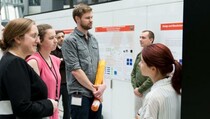Innovations in Blockchains, Intelligent Machines, Undersea Vehicles and More from Draper Fellows
CAMBRIDGE, MA—Innovation was on the agenda recently at Draper when new research was presented by 21 graduating master’s and Ph.D. students whose graduate study has been supported by the Draper Fellow Program. The research was wide-ranging, and the applications were real-world: finding your way in GPS-denied environments, detecting undersea vehicles meant to be stealthy, protecting blockchains from hacking and putting intelligence into human-machine teams.
The event was the Graduating Draper Fellow Highlights Poster Session, in which graduating Fellows present their thesis research in addressing and solving some of the most challenging technology and engineering problems.
The 2018 poster session did not disappoint. Kevin Ligonde, an MS student at Tufts University, presented technology in support of a brain"> wave detector in a cap that would make taking certain measurements much easier than using MRI for blood flow, magnetoencephalography (MEG) or electroencephalography (EEG).
Kristen Railey, a Ph.D. student at MIT, explained a new approach to passively detecting and tracking unmanned underwater vehicles—a method that may prove useful to protecting against autonomous undersea vehicles operating with malicious intent. And Brown University Ph.D. student Christopher Picardo developed a technique for processing imaging data that overcomes a deficit in cameras operating in low-light environments—an advance that could help aircraft succeed in search and rescue missions.
The 2018 Draper Fellows graduating class includes 21 students from Boston University, Brown University, the Massachusetts Institute of Technology, Northeastern University and Tufts University. Each year the program typically supports 55-65 graduate students.
Sheila Hemami, Director of Strategic Technical Opportunities at Draper, said the program, which she directs, provides an opportunity for students to benefit from not only immersion in their university’s academic research environment, but also from Draper’s facilities, collective knowledge and experience. “Draper’s technical depth and expertise provides synergy with each Fellow’s university research laboratories, and the Draper Fellow alumni network provides additional networking and mentoring opportunities. Draper is proud to support the world’s future technical leaders.”
Alumni of the Draper Fellow Program, founded in 1974, comprise more than 1,200 Draper Fellows from both civilian and military backgrounds who are excelling worldwide in technical, corporate, government, academic and entrepreneurship sectors. Notable alumni include military officers, executives at Fortune 500 companies and five NASA astronauts.
Details about the program, including how to apply, are available at Draper.
Released May 22, 2018
















